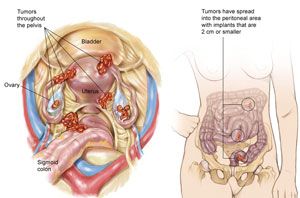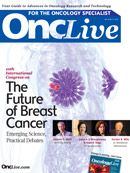Publication
Article
Oncology Live®
5 Abstracts Among SGO Highlights
Author(s):
This report highlights 5 abstracts relevant to the current and future management of patients with female pelvic malignancies.
Stage IIIB Ovarian Cancer

©2005 American Society of Clinical Oncology
More than 1700 healthcare professionals gathered at the 42nd Annual Meeting on Women’s Cancer that the Society of Gynecologic Oncologists (SGO) hosted in Orlando, Florida, in March. In all, approximately 50 abstracts, 227 posters, and 5 surgical films were presented. This report highlights 5 abstracts relevant to the current and future management of patients with female pelvic malignancies. Abstracts may be accessed in Gynecologic Oncology (2011;120[suppl 1]:S1-S150). http://tiny.cc/h2c8s
Bowel Disease Linked to Bevacizumab Toxicities
Investigators from the Gynecologic Oncology Group analyzed potential risk factors for the development of serious bevacizumab-associated gastrointestinal toxicities, including bowel perforation, among individuals who participated in the group’s phase III randomized trial examining the use of this antiangiogenic agent in the primary management of advanced epithelial ovarian cancer.
Several clinical factors were significantly associated with these potentially quite serious treatment-related side effects, including the performance of either small or large bowel resection as a component of the initial cytoreductive procedure.
While either of these procedures increased the risk of serious adverse gastrointestinal events approximately 2-fold compared with patients who did not require resection, the single clinical factor most associated with these complications of bevacizumab was a history of treatment for inflammatory bowel disease.
In this admittedly small patient population, the risk of serious gastrointestinal events was 13-fold greater than for patients without such a history. The data provide strong support for the conclusion that a history of treatment for inflammatory bowel disease should be considered a strong relative, if not absolute, contraindication to the administration of this antiangiogenic agent in women receiving primary chemotherapy for advanced ovarian cancer. Abstract 7.
Chemoradiation Promising in Vulvar Cancer
Another Gynecologic Oncology Group study explored a potential role for weekly cisplatin (40 mg/m2/week) combined with external beam radiation (180 cGy/day x 32 fractions) in women with locally advanced squamous cell vulvar cancer.
Although this was not a randomized trial, the results demonstrated impressive clinical activity, including a high percentage of women who achieved a pathologic complete response to the chemoradiation combination, for this multimodality approach to the management of this relatively uncommon but difficult malignancy. The results compare favorably with prior reported experiences with primary therapy in this clinical setting. Abstract 1.
Surgery Trend in Ovarian Cancer Examined
In an interesting examination of the Surveillance, Epidemiology and End Results national database, investigators attempted to examine the adherence of the oncology community to guidelines for the management of advanced epithelial ovarian cancer.
The analysis found that compared to 1995, when 67.5% of treated patients included in this database had surgery performed as their initial intervention, the percentage of patients undergoing surgery prior to chemotherapy had decreased to 52.8% in 2005.
While attempting to evaluate the quality of medical care being provided to patients based on the very limited information available in such national databases is fraught with considerable hazard, the investigators appeared to suggest that this apparent trend of less initial surgery implies less-optimal treatment. Abstract 2.
However, an alternative interpretation would be that the data support the increasing acceptance within the oncology community of the general concept of neoadjuvant chemotherapy often but not always followed by surgery as primary management of advanced ovarian cancer, an approach now validated by the results of a recently published landmark phase III randomized trial (N Engl J Med. 2010; 363:943-953).
Encouraging Outcomes in Uterine Carcinoma Trial
In an effort to improve the treatment for women with surgically resected localized papillary serous uterine carcinomas (stage I/II and advanced stage III/IV), investigators conducted a nonrandomized phase II trial combining the known highly active chemotherapy regimen of carboplatin (AUC 6) plus paclitaxel (175 mg/m2) with radiation (brachytherapy, external beam, or a combination of the 2 strategies).
This approach was designed to optimize the chances for both peritoneal cavity/systemic and pelvic control of this difficult malignancy. Of note, the radiation was delivered following 3 cycles of the chemotherapy regimen, which was then resumed after the completion of the regional treatment.
The therapeutic regimen was reasonably well tolerated, and the survival outcomes encouraging (recognizing this was not a randomized trial). Progression-free and overall survival for stage I/II disease were both approximately 4 years, while for women presenting with stages III/IV cancer the corresponding figures were 24 months and 34 months, respectively. Abstract 21.
CA-125 Predictive in Endometrial Cancers
In a provocative, large prospective analysis of clinical factors that may predict for the presence of extra-uterine spread in endometrial cancers that appear at presentation to be localized to the uterus, investigators identified an elevated baseline serum CA-125 level as being highly predictive for this finding.
Of note, an elevated tumor marker was even superior to the presence of poor morphologic differentiation in suggesting this outcome. Overall, nearly 50% of patients with apparently localized disease who had an elevated serum CA-125 antigen level were found to have extra-uterine spread of the malignancy. These data reveal the clinical utility of obtaining a serum CA-125 determination in patients with uterine cancer prior to the performance of surgical staging. Abstract 36.
Maurie Markman, MD, editor-in-chief of OncLive, is senior vice president for Clinical Affairs and national director for Medical Oncology at Cancer Treatment Centers of America, Eastern Regional Medical Center, Philadelphia, Pennsylvania. maurie.markman@ctca-hope.com










